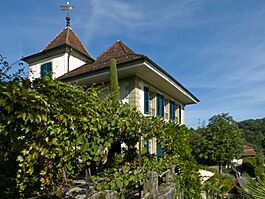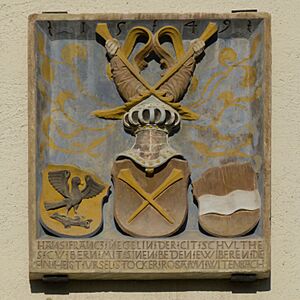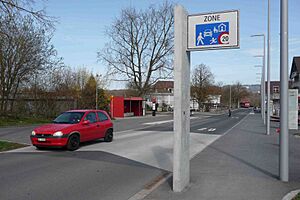Bremgarten bei Bern facts for kids
Quick facts for kids
Bremgarten bei Bern
|
||
|---|---|---|
 |
||
|
||
| Country | Switzerland | |
| Canton | Bern | |
| District | Bern-Mittelland | |
| Area | ||
| • Total | 1.9 km2 (0.7 sq mi) | |
| Elevation | 490 m (1,610 ft) | |
| Highest elevation
(Birchiwald)
|
589 m (1,932 ft) | |
| Lowest elevation
(Schlosshalbinsel)
|
488 m (1,601 ft) | |
| Population
(Dec 2020 )
|
||
| • Total | 4,340 | |
| • Density | 2,280/km2 (5,920/sq mi) | |
| Postal code |
3047
|
|
| Surrounded by | Bern, Kirchlindach, Zollikofen | |
Bremgarten bei Bern is a small town, also called a municipality, in Switzerland. It's located in the canton of Bern, which is like a state or region in Switzerland.
Contents
History of Bremgarten
Bremgarten bei Bern was first mentioned in old writings in 1180. Back then, it was called Bremecart. For a long time, until 1870, it was known as Bremgarten-Herrschaft.
People have lived in Bremgarten since Roman times. Archeologists have found old Roman settlements, roads, and coins here. In the Middle Ages, there was a castle and a village. The castle was home to the Lords of Bremgarten. It was built on a narrow part of the Aare river peninsula. The Lords of Bremgarten also had their own church, St. Michaels Church, which was built a very long time ago, around the 10th or 11th century.
In 1298, the town and castle were destroyed by the city of Bern after a big battle. But the town and castle were rebuilt. In 1306, the Lords of Bremgarten sold their land to a group of knights called the Knights Hospitaller. The castle then became the home of their leader.
Later, in 1529, the land became part of Bern. The old castle was mostly torn down, and a new, fancy country house was built in its place. Over the centuries, the castle was owned by many different important families from Bern. In the 1700s, parts of the castle were torn down again to build a beautiful summer palace. A new owner, Albrecht von Frisching, encouraged many people to move to Bremgarten to help him rebuild the castle. By 1780, the castle was completely new and surrounded by large courtyards and gardens.
In the 19th century, Bremgarten Castle changed owners many times. In 1918, a rich family bought it and fixed it up. They fully restored it in 1978.
After the French invaded Switzerland in 1798, Bremgarten got its own town council. The first bridge over the Aare river, called the Neubrügg, was built in 1466. However, Bremgarten was quite isolated until the 20th century. In 1921, a much bigger bridge, the Seftausteg, was built. Then, in 1928, the Felsenaubrücke was built by the army.
For a long time, the town didn't have much money. It even tried to become part of Bern several times. But in the 1950s, many new buildings were constructed, which helped solve some of the town's money problems. Bremgarten doesn't have much industry. Most people who live there travel to Bern for work. It's often called a "bedroom community" because many people sleep there but work somewhere else.
Geography of Bremgarten
Bremgarten bei Bern covers an area of about 1.9 square kilometers (0.73 square miles). A big part of this area, about 31.9%, is used for farming. Forests cover about 16.2% of the land. The largest part, 45.5%, is covered by buildings and roads. A small part, 4.2%, is rivers or lakes.
The town is located near Bern, on the right side of the Aare river. It includes the main village of Bremgarten bei Bern and several smaller neighborhoods like Seftau-Ländli and Kalchacker.
Coat of Arms
The coat of arms for Bremgarten bei Bern has a special design. It is split into two parts. The top part has six vertical stripes, alternating between silver (white) and black. The bottom part has six horizontal stripes, also alternating between silver (white) and black.
People of Bremgarten (Demographics)
Bremgarten bei Bern has a population of about 4,400 people. About 8.8% of the people living there are from other countries. Over the last 10 years, the population has grown by about 10.9%.
Most people in Bremgarten speak German as their main language (about 92.3%). Some people also speak French (2.0%) or Italian (1.1%).
In 2008, about 47.2% of the population were male and 52.8% were female. About 20.3% of the population are children and teenagers (0–19 years old). Adults (20–64 years old) make up 58.6%, and seniors (over 64 years old) make up 21.1%.
The number of people living in Bremgarten has changed a lot over time, as you can see in this chart:

Important Heritage Sites
Bremgarten Castle is a very important historical site in Switzerland. It's listed as a heritage site of national significance. This means it's a special place that helps tell the story of Switzerland.
During the Protestant Reformation in 1528, the castle was given to Peter Englisberg, a leader of the Knights Hospitaller, as a reward.
A famous Swiss painter named Ricco grew up in Bremgarten Castle. His parents, Max and Tilli Wassmer, used to host amazing parties there. Many famous poets, painters, and composers would visit. The famous writer Hermann Hesse even wrote about the atmosphere of the castle in one of his stories.
Economy and Jobs
In 2011, Bremgarten bei Bern had a low unemployment rate of 1.3%. This means most people who wanted a job had one.
In 2008, there were 550 people working in the municipality.
- A small number of people (16) worked in the primary sector. This means they worked in farming.
- Some people (34) worked in the secondary sector. This includes jobs in manufacturing (making things) and construction (building things).
- Most people (500) worked in the tertiary sector. This includes jobs in services, like sales, hotels, restaurants, healthcare, and education.
Many people who live in Bremgarten travel to other places for work. About 40.8% use public transportation, and 38.5% use a private car to get to their jobs.
Religion
According to a census in 2000, most people in Bremgarten bei Bern are Christian. About 17.1% were Roman Catholic, and 64.2% belonged to the Swiss Reformed Church. There were also smaller groups of other Christian churches, and some people who were Islamic or Jewish. A small number of people belonged to other religions like Buddhism or Hinduism. About 10.42% of the population did not belong to any church.
Education
In Bremgarten bei Bern, many people have a good education. About 41.0% of the population have finished upper secondary education, which is like high school. And 23.5% have gone on to higher education, like a university.
The school system in the Canton of Bern starts with one year of optional Kindergarten. After that, students go to six years of Primary school. Then, they have three years of lower Secondary school. In secondary school, students are grouped based on their abilities. After lower secondary, students can choose to continue their schooling or start an apprenticeship to learn a trade.
In the 2009-10 school year, there were 430 students in Bremgarten bei Bern. There were 4 kindergarten classes with 69 students and 13 primary classes with 251 students. There were also 6 lower secondary classes with 110 students.
Notable People
Here are some famous people who were born or lived in Bremgarten:
- Adrian Frutiger, a famous designer of typefaces (the way letters look).
- Ricco (1915–1972), a well-known painter.
See also
 In Spanish: Bremgarten bei Bern para niños
In Spanish: Bremgarten bei Bern para niños










